Mastering the Art of Braising
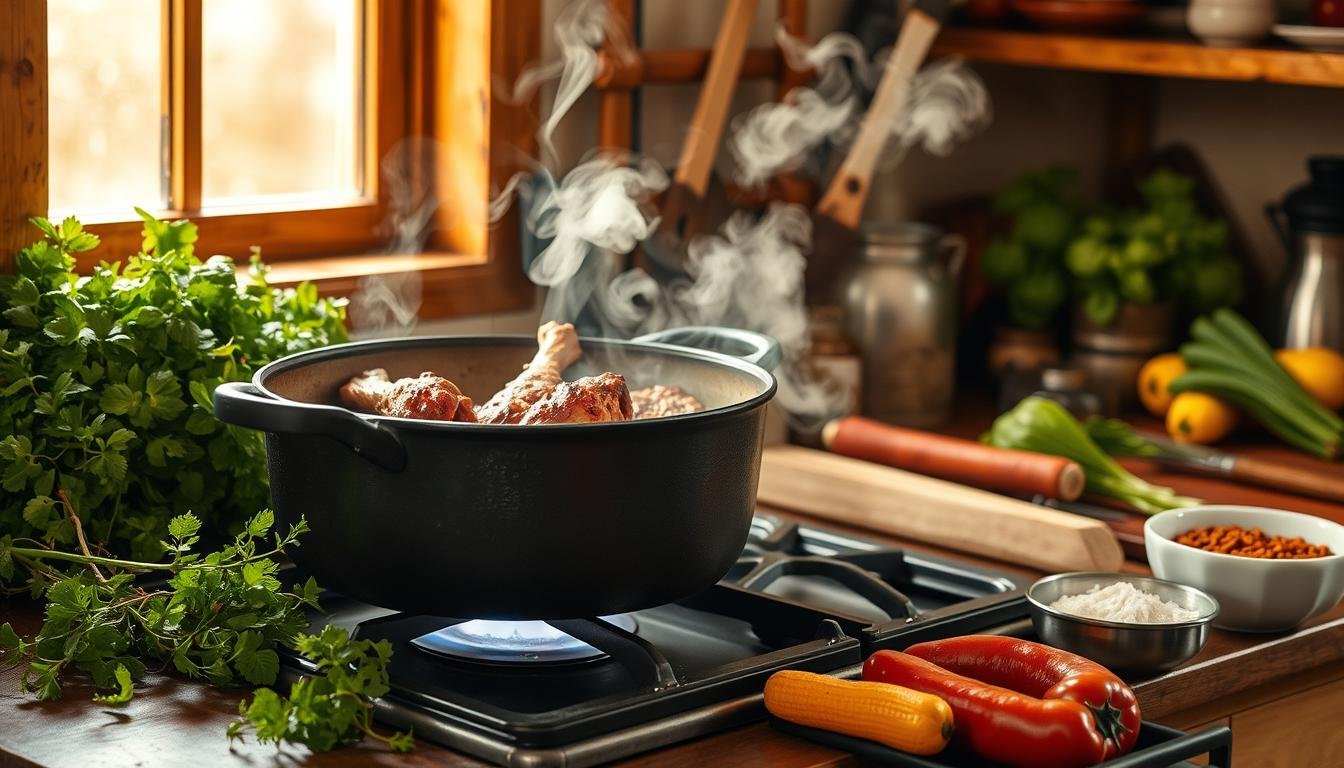
Have you ever asked why some home-cooked meals are as good as those in fancy restaurants? It’s often because of braising. This method slow cooks meat with tasty ingredients, making it soft and delicious. Are you ready to learn this skill and make amazing meals?
Braising is great for making heartwarming, tasty dishes. By learning this technique, you can make complex meals easily. This guide will show you everything about braising, like picking the best tools and ingredients.
Now is a great time to start braising. There are special deals like double points on Tony’s Butcher Pantry items from October 3 – October 30, 2024. Plus, discounts on things you need, like brisket, pork shanks, and ready-made chicken stock.
Key Takeaways
- Learning to braise can really improve your cooking skills.
- Tony’s Butcher Pantry has great deals for braising recipes.
- With the right stuff, anyone can make yummy, tender braised meals.
- Braising cooks food slowly at low heat, making it taste better.
- Key steps include good searing, using aromatics, and keeping food moist while cooking.
What is Braising?
Braising is a way to cook food so it’s really tender and tasty. It starts with browning the food, like meat, in a pot. Then, it cooks slowly in a little liquid. This method is great for making dishes like braised short ribs and chicken. The liquid adds extra flavor and keeps everything moist.
Definition and Overview
Braising turns tough ingredients into soft, yummy treats. It has two steps. First, you brown the meat. This adds deep flavors. Then, you cook it slow in liquid, like broth or wine. This makes the meat soft.
Historical Context
People around the world have been braising for ages. It’s big in Europe for meats like pork shanks. In India, it’s used in dishes like mutton curry. It’s loved for making simple food taste amazing.
Popular Braising Techniques
The key braising techniques are:
- Sear the Meat: Brown the meat for great taste.
- Add Liquid: Use broth or wine for cooking with the meat.
- Low and Slow Cooking: Cook it on low heat so it gets tender over time.
Modern pots and pans make braising better by cooking evenly. Now is a good time to try it with items like Brisket and Pork Shanks on sale.
Comparative prices for braising essentials during October:
| Product | Price (Per LB) | Regular Price (Per LB) |
|---|---|---|
| Flat Cut Brisket | $11.98 | $12.98 |
| Pork Shanks | $2.98 | $3.98 |
| Chicken Stock | $4.98 | $5.98 |
Equipment You Need for Braising
Mastering braising needs skill and the right tools. Good equipment makes dishes flavorful and tender.
Essential Cookware
A heavy, lidded pot like a Dutch oven is key for braising. It keeps heat even. A Dutch oven makes flavors better and moves easily from stove to oven. You can use foil-covered aluminum pans too, but they’re not as consistent.
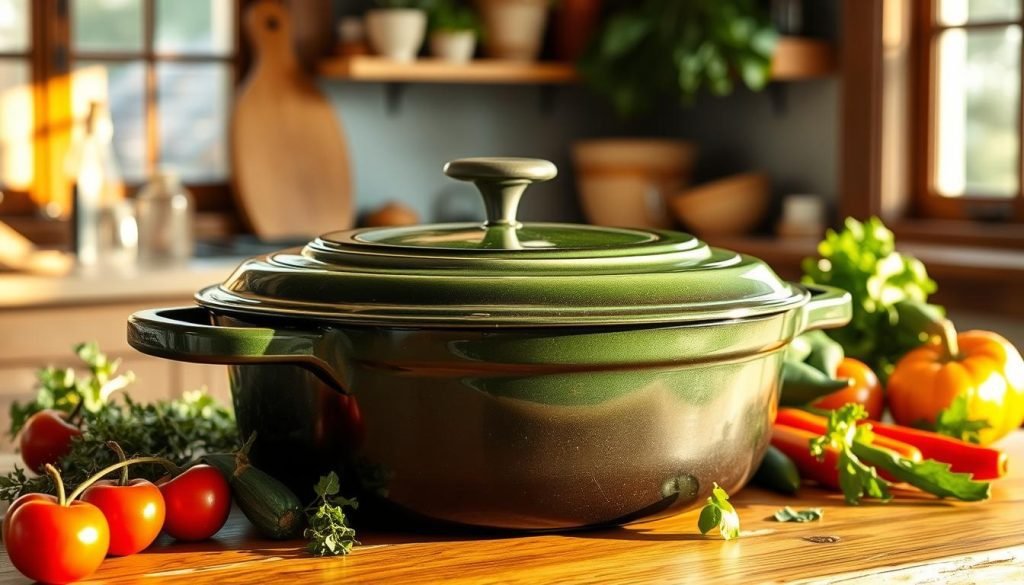
Starting some recipes with boiling at 212 degrees Fahrenheit is important. It changes the proteins and melts fat. This step helps get the right texture and taste.
Recommended Tools and Gadgets
Other tools also improve braising. A meat thermometer checks if meat is cooked right. Tongs make handling seared meat easy and safe.
Right seasoning is important too. Use salt, brown sugar, spices, and black pepper for taste. Let the meat sit overnight for deep flavors and tenderness.
A slow cooker is crucial as well. Cooking slow at 300 degrees Fahrenheit for two hours makes meat tender. This way, meat like bone-in short ribs becomes very tender.
| Item | Purpose |
|---|---|
| Heavy, Lidded Pot (e.g., Dutch oven) | Maintains consistent heat distribution |
| Meat Thermometer | Monitors internal meat temperatures |
| Tongs | Safe handling of hot, seared meat |
| Slow Cooker | Optimal slow cooking for tender results |
Choosing the Right Cut of Meat
Picking the right meat cut is key for perfect braised beef. It’s about understanding meat grades and choosing well for braising. This will make your dishes stand out.
Understanding Meat Grades
The USDA grades meat importantly. Beef is graded as Prime, Choice, and Select. Prime has lots of marbling, making it tender and flavorful. It’s best for high-end dishes. Choice is also good, great for daily fancy meals. Select, being leaner, gets better with braising.
Best Cuts for Braising
Braising is best for tough cuts. It makes them tender after long cooking. Here are cuts to choose:
- Chuck: It has lots of connective tissue. Slow braising makes it tender.
- Brisket: It’s tasty but needs long cooking for softness.
- Short Ribs: They have a good meat-to-fat ratio for juicy dishes.
- Shank: Its collagen turns into a yummy gel-like substance when cooked.
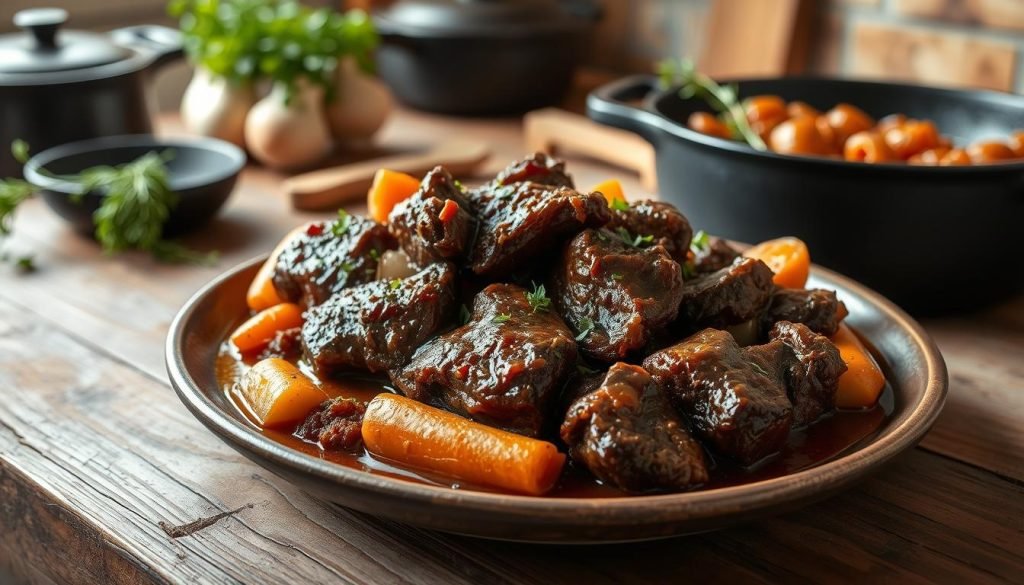
Tips for Selecting Quality Meat
Keep these tips in mind when picking meat:
- Marbling: Choose cuts with fat throughout for flavor and moisture.
- Freshness: Look for meat that’s brightly colored and firm. Fresh meat cooks best.
- Locally Sourced: Local butchers often have fresher, high-quality meats.
- Grass-Fed Options: Grass-fed and organic mean fewer antibiotics and hormones.
Knowing about meat selection makes a big difference. It can turn your braised beef into a dish that shows off your cooking skills.
Preparing Ingredients for Braising
Getting ingredients ready is key to good braising. Each part, from the aromatics to the sides, affects the taste and feel of your dish.
Importance of Ingredient Prep
Braising pays off when you prep well. Curing meat with salt and brown sugar makes it tender and tasty. Browning the meat first adds richness, but doing it to just some pieces works best.
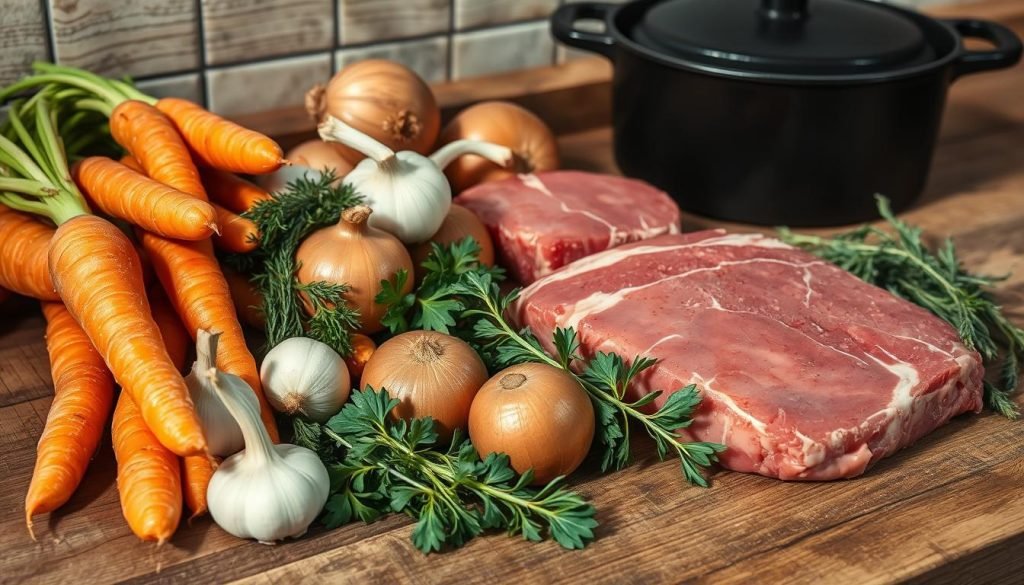
Aromatics and Flavors
Onions, garlic, and carrots build the dish’s flavors. Cook them until soft for the best taste. Adding herbs like thyme and rosemary at the right time improves your cooking.
Accompaniments to Consider
Besides the meat, veggies and sides add to the meal. Stewing vegetables are a great deal now. Adding things like Tony’s Steak Chili Starter or Chicken Stock enhances flavor. Mashed potatoes make a filling side.
| Product | Regular Price | Promotion Price |
|---|---|---|
| Flat Cut Brisket | $12.98 per lb | $11.98 per lb |
| Pork Shanks | $3.98 per lb | $2.98 per lb |
| Chef Prepared Chicken Stock | $5.98 per lb | $4.98 per lb |
| Tony’s Steak Chili Starter | $6.99 each | $4.99 each |
| Stewing Vegetables | $5.98 per lb | $4.59 per lb |
The Braising Process Step-by-Step
Braising mixes dry and moist heat to soften tough meat. It turns budget cuts into tasty meals by slow cooking. Let’s learn how to do it step by step.
Searing the Meat
Searing meat is the key first step. It makes a crust and adds flavor. Chef Barry E. Sexton knows this well after 30 years. Use a little oil in a pot or skillet to brown the meat well on all sides.
Adding Liquid and Aromatics
After browning the meat, add liquid and veggies. The liquid should partly cover the meat. You can use broth, wine, or beer. Add aromatics like onions, garlic, and herbs to make it tasty. Then, scrape the pot’s bottom with a bit of liquid.

Covering and Cooking
Next, cover the pot and bake it. Set the oven between 300°F to 350°F. Cooking slowly may take hours but makes the meat tender. It’s done when it’s easy to pull apart but not mushy.
| Cut of Meat | Cooking Time | Braising Liquid | Aromatics |
|---|---|---|---|
| Beef Chuck Roast | 3-4 hours | Red Wine | Rosemary, Onions |
| Pork Shoulder | 4-6 hours | Beer | Paprika, Garlic |
| Lamb Shanks | 2-3 hours | Broth | Thyme, Carrots |
To master braising, be patient and enjoy slow cooking. By following these steps carefully, you’ll create delicious, tender dishes.
Cooking Times and Temperatures
Knowing the right braising time and braising temperature is key to good braising. If done right, the meat becomes tender and tasty. This guide will help you nail it every time.
Optimal Cooking Times
Different meats and sizes mean different braising times:
- In a pressure cooker, meat gets tender in 30 minutes at 250°F (120°C).
- Stewing meat softens in 15 minutes, but a big pot roast needs 45 minutes.
- A slow cooker makes meat tender in 6 to 8 hours at 170°F (75°C) to 175°F (80°C).
- Simmering on the stove or oven takes 2 to 3 hours at 185°F (85°C) to 195°F (90°C).
Temperature Guidelines
The right braising temperature cooks meat well and keeps it moist:
- A low oven temp can be around 200°F (95°C), but it slows down cooking.
- Meat loses about a third of its weight in fat and juices during cooking.
- When cooked right, a fork slides in and out of the meat easily.

| Cooking Method | Braising Time | Braising Temperature |
|---|---|---|
| Pressure Cooking | 15 – 45 minutes | 250°F (120°C) |
| Slow Cooking | 6 – 8 hours | 170°F (75°C) – 175°F (80°C) |
| Simmering (Stove or Oven) | 2 – 3 hours | 185°F (85°C) – 195°F (90°C) |
With careful attention to braising time and braising temperature, your dish will come out perfectly tender and full of flavor.
Flavor Enhancement Techniques
Getting braising right involves the ingredients and cookware you choose. Yet, it’s also about the flavor-boosting methods you use. By picking the right herbs, spices, and liquids, you can take your braising to the next level. Here are some key tips for enriching flavors.
Using Herbs and Spices
The aroma of a dish is key to its success. Herbs like rosemary, thyme, and bay leaves enhance flavor. Spices such as cumin and chili add a special touch. Choosing the right herbs and spices makes dishes taste amazing. Every bite becomes a flavor-packed experience.
Adding Alcohols and Acids
Using beer or wine can make a dish more interesting. A red wine like Cabernet Sauvignon is great with beef. White wine like Chardonnay is perfect with chicken. Vinegar or lemon juice adds a refreshing taste. These ingredients make your dish stand out.

Finishing Touches
Towards the end, adding fresh herbs or cream can do wonders. Try parsley, dill, or a balsamic reduction. These small additions can elevate your dish. A tasty broth or stock is also key. It’s the base of a great dish.
Serving Suggestions
Thoughtful pairings make your braised dishes stand out. Let’s find sides that match braising. Also, tips to make your meal look and taste amazing.
Side Dishes that Pair Well
Chefs like rich braises with sides that add contrast. Here are some ideas:
- Creamy Mashed Potatoes: They’re smooth and buttery, perfect with tender meat.
- Roasted Vegetables: Carrots, parsnips, and brussels sprouts bring a healthy touch.
- Buttered Noodles: These noodles soak up flavors, simple and tasty.
- Braised Lotus Root: Adds crunch and unique taste, plus vitamins and minerals.
Presentation Tips
To make a dish unforgettable, presentation is key. Here’s how to wow your guests:
- Use Fresh Garnishes: Fresh herbs add color and flavor, like parsley or thyme.
- Think About Color: Balance colors for eye appeal. Green veggies make dark meats pop.
- Arranging the Plate: Centralize the main dish. Arrange sides neatly around it. This highlights each part of your meal.
- Serving in Style: Quality serving items keep food warm. A Dutch oven or skillet adds charm.
Great sides and presentation make dining a joy. It pleases the eyes and tastes.
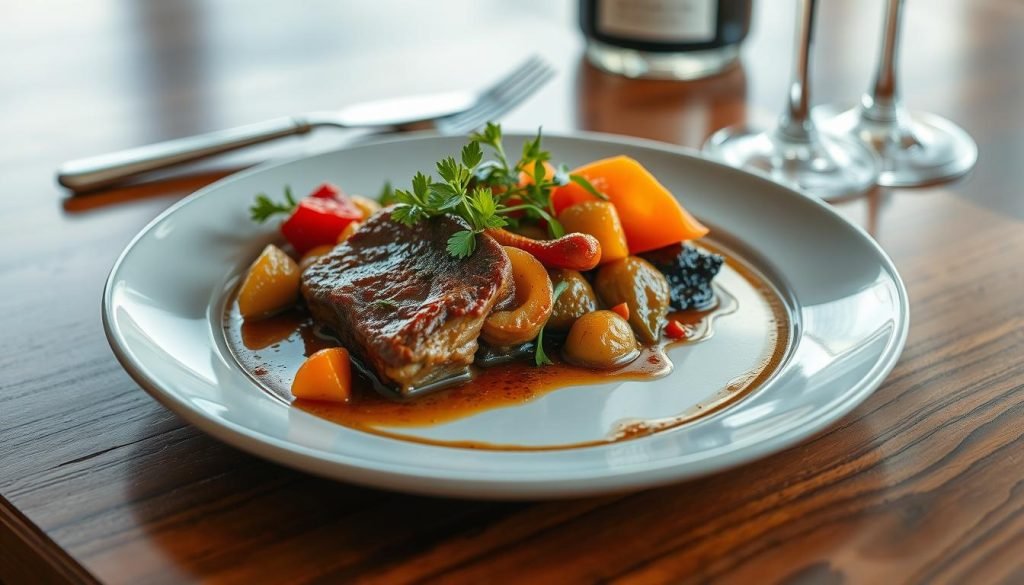
Common Mistakes to Avoid
Even expert cooks can mess up braising. Here are tips to dodge common errors. These errors happen to many cooks.
Overcooking or Undercooking
Getting braised meat just right is key. Beef usually cooks between 1.5 to 3 hours. Vegetables take 30 to 60 minutes. Overcooking makes meat tough and dry. Undercooking keeps flavors from merging. Keep your oven set between 275°F and 300°F. On the stove, a gentle simmer is best. This prevents the meat from getting too tough.
Skipping the Searing Step
Don’t miss out on searing meat before braising. It adds depth and locks in nutrients. Missing this step makes dishes taste dull. If you crowd the pan, meat steams instead of browns. Make sure there’s enough room for a proper sear. This is vital for the taste.
Ignoring Flavor Balance
Balance is key in braising. Use flavorful liquids like wine or beer, not just water. Not deglazing the pan means missing out on taste. Also, the right amount of liquid is important. It should only come halfway up the meat. Season the meat and liquid well for the best flavor.